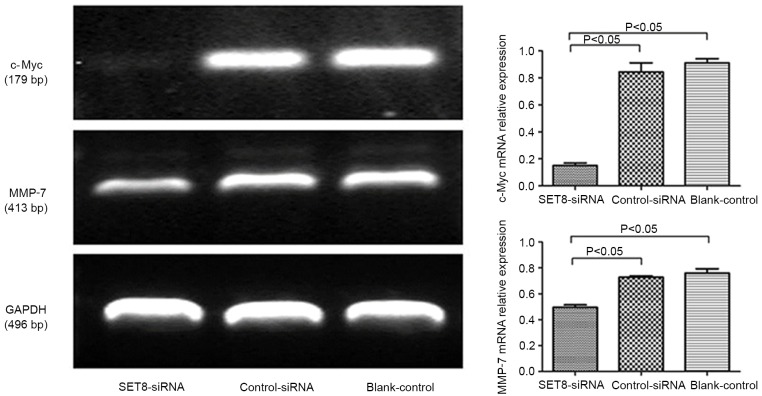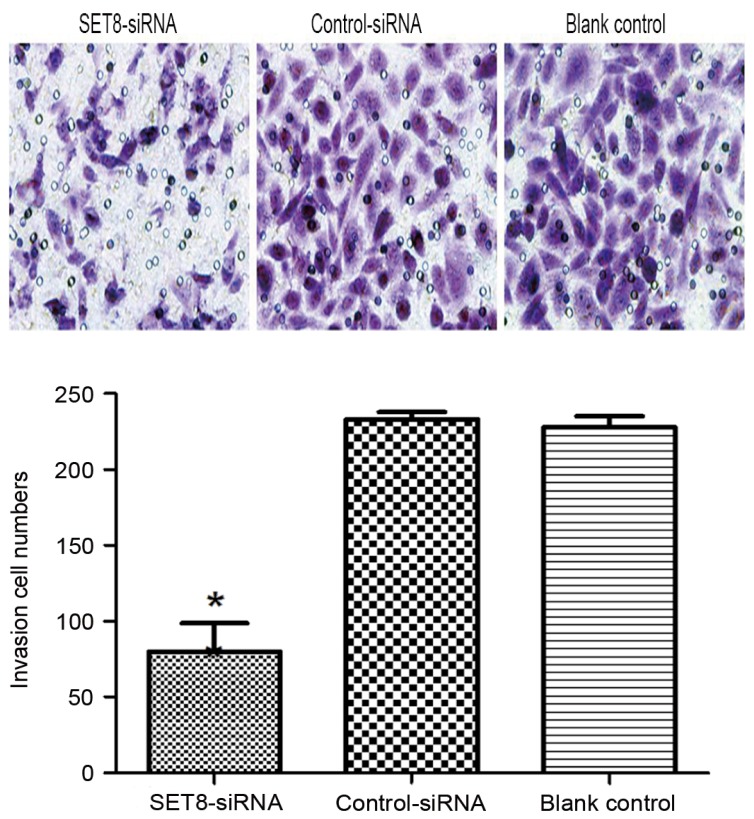Abstract
Genetic variants may affect the interactions between microRNAs (miRNAs/miRs) and their target genes by modulating their binding affinity or by creating, or destroying a miRNA-binding site. SET domain containing (lysine methyltransferase) 8 (SET8) is the sole lysine methyltransferase that catalyzes the monomethylation of histone H4 lysine 20, and is associated with tumor growth, invasion and metastasis. In the present study, the rs16917496 polymorphism within the miR-502 binding site of the SET8 mRNA 3′ untranslated region (3′UTR) in patients with clear cell renal cell carcinoma (ccRCC) and healthy controls was genotyped. The SET8 CC genotype was associated with a decreased ccRCC risk compared with the CT [P=0.003; odds ratio (OR)=0.318; 95% confidence interval (CI), 0.146–0.691], TT (P=0.011; OR=0.402; 95% CI, 0.197–0.819) and CT+TT (P=0.004; OR=0.370; 95% CI, 0.186–0.736) genotypes. The SET8 CC genotype was associated with reduced SET8 expression based on immunostaining of ccRCC tissue. Low SET8 protein levels were negatively associated with tumor-node-metastasis staging in patients with ccRCC according to the size of tumor and lymph node metastases. SET8-knockdown inhibited renal carcinoma 786-O cell proliferation, migration and invasion. c-Myc and matrix metalloproteinase-7 mRNA expression were downregulated upon SET8-knockdown in renal carcinoma 786-O cells. These data indicated that SET8 may be a functional tumor promoter and that its activation, which is partially regulated by changing the miR-502 and SET8 3′UTR binding affinity, may serve an important role in ccRCC development.
Keywords: clear cell renal cell carcinoma, histone methyltransferase SET8, microRNA-502, cancer risk, polymorphism
Introduction
Renal cell carcinoma (RCC) occurs in 2–3% of adult malignancies, with ~337,860 new cases and 143,406 mortalities worldwide in 2012 (1). The global incidence of RCC increased gradually between 1997 and 2007 (2). In China, there are ~66,466 cases of RCC annually, making it the third most prevalent genitourinary cancer (3). Several risk factors have been associated with RCC, including smoking, alcohol use, hypertension and obesity (4). However, numerous individuals exposed to these risk factors in their lifetime do not develop RCC. Accumulating evidence has suggested that genetic and environmental factors perform important roles in the development of RCC (5). MicroRNAs (miRNAs/miRs) have recently been implicated in RCC tumorigenesis (6,7).
miRNAs are a class of small, single-stranded, noncoding RNAs that modulate gene expression by binding to the 3′ untranslated region (3′UTR) of their target genes, causing translational suppression and/or mRNA degradation (8,9). Accumulating evidence has suggested that miRNAs perform important roles in a broad range of biological processes, including cellular proliferation, apoptosis, differentiation and cancer development (10). To regulate mRNA and protein expression levels, miRNAs bind to the 3′UTR of their target mRNAs. Thus, single nucleotide polymorphisms (SNPs) in the 3′UTR may impede existing binding sites or create novel binding sites, resulting in the misregulation of target genes, which may affect the tumor risk of an individual (11,12). SET domain containing (lysine methyltransferase) 8 (SET8; also termed PR-Set7, SETD8 or KMT5A) is a SET domain-containing methyltransferase family member, and is modulated by miR-502 binding to its 3′UTR (13,14). SET8 encodes a histone H4 lysine 20 monomethyl transferase that has been implicated in modulating cell cycle progression and development (14–16). It was previously reported that SET8 is recruited to DNA replication foci through its interaction with proliferating cell nuclear antigen and is required for proper DNA replication (17,18). The precise modulation of SET8 levels is important for proper cell cycle progression, and the inability to modulate SET8 expression results in severe cell cycle defects (17–20). Previous studies have revealed that SET8 is highly expressed in several types of tumors, including breast cancer (21), small cell lung cancer (22), hepatocellular carcinoma (11) and ovarian cancer (23). Furthermore, SET8 expression levels were identified to be associated with the rs16917496 SNP in the SET8 3′UTR (21).
In the present study, the rs16917496 SNP in patients with ccRCC in a case-control study was genotyped to assess its association with the risk of cancer. In addition, the association between this SNP and SET8 expression, and the roles of SET8 in renal carcinoma 786-O cell proliferation, migration and invasion were examined using RNA interference.
Materials and methods
Tissue specimens and DNA extraction
Blood samples were obtained from 140 patients with ccRCC, which were all treated at The Fourth Affiliated Hospital of Hebei University (Hebei, China) between December 2006 and December 2010. The ccRCC patients included 59 males and 81 females, mean age 56.8 years (range, 36–79 years). Blood samples were also acquired from age-matched healthy controls. Total DNA was extracted using a Wizard Genomic DNA Extraction kit (Promega Corporation, Madison, WI, USA) according to the manufacturer's protocol and stored at −20°C. The present study was approved by the Ethics Committee of The Fourth Affiliated Hospital of Hebei Medical University and written informed consent was acquired from all recruited patients.
PCR amplification and sequence analysis
The primers for amplification were 5′-CCTGGTCAGTGGTCAGCAAAT-3′ (sense) and 5′-CTGGGAAACACGCTCAAAATC-3′ (antisense) for rs16917496 in the 3′UTR of SET8 (National Center for Biotechnology Information database: http://www.ncbi.nlm.niih.gov/snp). PCR was performed on DNA isolated from blood samples using a PCR Master Mix kit according to the manufacturer's instructions (Promega Corporation), The PCR condition consisted of incubation for 2 min at 95°C followed by 35 cycles of 30 sec at 95°C, 30 sec at 55°C and 45 sec at 72°C, with a final extension step at 72°C for 5 min. The PCR product was used for sequencing. Cycle sequencing was performed using the Dye Terminator Cycle Sequencing Ready Reaction kit (Applied Biosystems; Thermo Fisher Scientific, Inc., Waltham, MA, USA), according to the manufacturer's protocol, and the products were analyzed on the ABIPRISM Genetic Analyzer 3100 (Applied Biosystems; Thermo Fisher Scientific, Inc.). Polymorphisms were identified by repeated analyses of the two strands.
Measurement of SET8 levels in ccRCC tissue
SET8 protein expression was determined by immunostaining, which was performed on serial histopathological sections from RCC tissue. RCC tissues were fixed in 10% formalin overnight at room temperature and paraffin-embedded. The thickness of the RCC tissue sections was 5 µm. The primary antibody against SET8 (Abcam, Cambridge, UK; cat. no. ab3798) was applied to sections at a dilution of 1:100 overnight at 4°C, and sections were subsequently incubated with a biotinylated secondary antibody at a dilution of 1:10,000 (ProteinTech Group, Inc., Chicago, IL, USA; cat. no. SA00003-1) for 1 h at room temperature. The sections were then incubated with horseradish peroxidase (HRP)-conjugated streptavidin (Origene Technologies, Inc., Beijing, China; cat. no. K156617 J) at 37°C for 30 min and developed using 3,3-diaminobenzidine.
Stained slides were scored by two independent experienced pathologists without knowledge of the patients' clinical data. Immunostaining results were semi-quantified using HSCORE as reported previously (24,25) under a light microscope at magnification of ×200. Briefly, the score was calculated based on estimates of the percentage of positively stained renal cells in each intensity category (0, 1+, 2+, 3+, 4+). The intensity of staining of the antibody was analyzed by HSCORE. The HSCORE was calculated using the following equation: HSCORE=(i+1) π, where i=1, 2, 3 or 4, and π varies between 0 and 100%. A score of >100% was defined as high expression and ≤100% was defined as low expression (Fig. 1).
Figure 1.
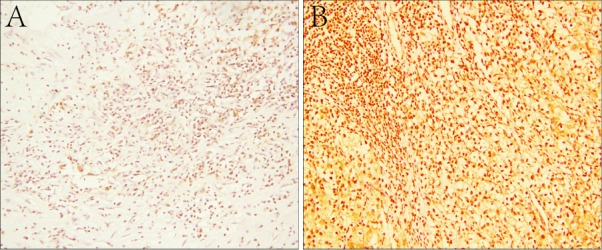
SET8 expression in ccRCC tissues. SET8 immunostaining in ccRCC tissues with (A) low expression and (B) high expression. Cells with a brown-stained nucleus were considered positive. Original magnification, ×200. ccRCC, clear cell renal cell carcinoma; SET8, SET domain containing (lysine methyltransferase) 8.
Cell culture and transfection
The renal carcinoma 786-O cell line was purchased from the Institute of Biochemistry and Cell Biology, Chinese Academy of Sciences (Shanghai, China) and cultured in RPMI-1640 medium supplemented with 10% fetal bovine serum (FBS), 50 IU/ml penicillin and 50 mg/ml streptomycin (all Gibco; Thermo Fisher Scientific, Inc., Waltham, MA, USA) at 37°C in a standard humidified incubator containing 5% CO2.
The renal carcinoma 786-O cells were transfected with psi-H1-SET8 small interfering (si)RNA or psi-H1 plasmids (GeneCopoeia, Inc., Rockville, MD, USA) using Lipofectamine 2000 (Invitrogen; Thermo Fisher Scientific, Inc.) according to the manufacturer's protocol. The target sequences of four siRNAs against SET8 were as follows: SET8-siRNA1, 5′-CAGAAUCGCAAACUUACGGA-3′; SET8-siRNA2, 5′-GAAUGAAGAUUGACCUCAUCG-3′; SET8-siRNA3, 5′-GCCUAGGAAGACUGAUCAAU-3′; and SET8-siRNA4, 5′-GGCGCUCACUGAAGUGUAUG-3′. Successful knockdown of SET8 was confirmed by western blot analysis using an anti-SET8 antibody (Abcam; cat. no. ab3798).
Western blot analysis
Radioimmunoprecipitation assay lysis buffer (150 mM NaCl, 1% NP40, 0.5% sodium deoxycholate, 0.1% SDS, 50 mM Tris, Ph 7.9, 10 mM NaF, PMSF, and 1X protease inhibitors (Roche Diagnostics, Basel, Switzerland) was used to isolate total protein from all the experimental renal carcinoma 786-O cells. The Bradford assay was used to determine protein concentration. Western blot analysis was performed as described previously (26). Briefly, 40 µg of total protein for each lane was separated on a 10% denaturing polyacrylamide gel and transferred to a polyvinylidene difluoride membrane (Roche Diagnostics). Immunoblots were probed with a mouse monoclonal anti-SET8 antibody at 1:500 (Abcam; cat. no. ab3798) or β-actin at 1:20,000 (Santa Cruz Biotechnology, Inc., Dallas, TX, USA; cat. no. SC-47778A). Membranes were blocked in TBS-Tween-20 containing 5% nonfat dry milk for 1 h at room temperature and incubated overnight with primary antibody at 4°C. A HRP-conjugated anti-mouse IgG antibody was used as the secondary antibody (ProteinTech Group, Inc, Chicago, IL, USA; cat. no. SA00003-1) for 2 h at room temperature. Signals were detected using FluorChem® HD2 (Alpha-InnoTec, San Leandro, CA, USA).
RNA extraction and reverse transcription-polymerase chain reaction (RT-PCR)
Total RNA was extracted from cultured cells using TRIzol (Invitrogen; Thermo Fisher Scientific, Inc.) one-step method according to the manufacturer's protocol. RNA (2 µg) was used for reverse transcription to synthesize template cDNA a using RevertAid First-Strand cDNA Synthesis kit (Thermo Fisher Scientific, Inc.) according to the manufacturer's instructions.
GAPDH gene was used as an endogenous control. The primer sequences are listed in Table I. PCR was performed using the Quantstudio™ Dx PCR instrument (Thermo Fisher Scientific, Inc.) and iQ™ SYBR-Green Super mix (Bio-Rad Laboratories, Inc., Hercules, CA, USA), which contained 5 ng cDNA and 10 pM of each primer. PCR reaction started with 1 cycle of 95°C for 10 min, followed by 40 cycles of three steps as 94°C for 30 sec, 58°C for 30 sec, and 72°C for 30 sec. The PCR products were electrophoresed on a 1.5% agarose gel and visualized with ethidium bromide staining, and the data were normalized to the endogenous control gene GAPDH using the 2−ΔΔCq method (27).
Table I.
Reverse transcription-polymerase chain reaction primers.
| Gene | Primer sequence | Amplicon, bp |
|---|---|---|
| c-Myc | F: 5′-CCTACCCTCTCAACGACAGC-3′ | 179 |
| R: 5′-TTCCTCCTCAGAGTCGCTGC-3′ | ||
| MMP-7 | F: 5′-TGGGAACAGGCTCAGGACTAT-3′ | 413 |
| R: 5′-AATGGGTAGGAGTCCCCATGA-3′ | ||
| GAPDH | F: 5′-CAAGGTCATCCATGACAACTTTG-3′ | 496 |
| R: 5′-GTCCACCACCCTGTTGCTGTAG-3′ |
MMP-7, matrix metalloproteinase-7; F, forward; R, reverse.
Cell proliferation assay
Cell proliferation was analyzed by MTT (Sigma-Aldrich; Merck KGaA, Darmstadt, Germany) assay as described previously (26). Cells were seeded in sextuplicate at 1×103 cells/well on 96-well microplates and transfected with SET8 siRNA-2 or negative control plasmids using Lipofectamine 2000. The cells were incubated with 100 µl MTT (0.5 mg/ml; Sigma-Aldrich; Merck KGaA) for 4 h at 37°C after various time periods of SET8-knockdown (0, 12, 24, 36, 48 and 72 h). Following centrifugation (room temperature, 10 min at 1,000 × g), 100 µl of 0.04 mol/l HCl-isopropanol was added to the cells. The absorbance was measured at 490 nm using an ELISA microplate reader. The experiment was repeated three times.
Colony formation assay
The renal carcinoma 786-O cells were seeded on 6-well plates at a density of 500 cells/well at 48 h post-transfection. After 10 days at 37°C in 5% CO2, the cells were fixed with 95% methanol and stained with 0.1% crystal violet for 15 min at room temperature. Colonies of >50 cells were scored under a light microscope at a magnification of ×100. The colony formation ratio (%) was calculated as follows: (Number of cell colonies/500) ×100.
Wound healing assay
At 48 h post-transfection, the cell monolayer was scraped in a straight line using a 200-µl pipette tip to create a scratch once they reached 100% confluence. The medium was removed and the cells were washed twice in PBS. Wound healing results were observed under a light microscope at a magnification of ×100. Images were captured at 0 and 12 h after scratching. At least five fields were analyzed for each scratch, and the migration index was calculated as the width of a scratch divided by the initial width of the same scratch, as previously described (28).
Cell invasion assay
Cell invasion assays were performed using a Transwell assay (pore size, 8 µm; Corning Incorporated, Corning, NY, USA). The insert was coated with 30 µl Matrigel (BD Biosciences, Franklin Lakes, NJ, USA) mixed with RPMI-1640 serum-free medium in a 1:5 dilution for 30 min at 37°C. At 24 h post-transfection, 100,000 cells were resuspended in 100 µl serum-free medium and plated in the upper chamber. The bottom chamber was filled with 500 µl RPMI-1640 containing 10% FBS. Following incubation for 24 h at 37°C, the upper chamber was removed, and non-penetrating cells were gently wiped away. The remaining cells were stained with 0.1% crystal violet for 15 min at room temperature and counted under a light microscope (Axio Observer D1, Gemney) in five representative areas at 400x, irrespective of staining intensity or cell number. The experiment was repeated three times. The cell invasion inhibition rate (%) = [1-(the number of invasive cells in the experimental group / the number of invasive cells in the control group)] ×100.
Statistical analysis
Data are presented as the mean ± standard deviation. A χ2 test was used to analyze dichotomous values. The odds ratio (OR) and 95% confidence interval (CI) were calculated using an unconditional logistic regression model. Student's t-test was performed to analyze results of MTT, colony formation, migration and invasion assays. All statistical analyses were performed using SPSS 17.0 software (SPSS, Inc., Chicago, IL, USA). P<0.05 was considered statistically significant for all statistical tests.
Results
SET8 genotype is associated with ccRCC risk
A total of 140 patients with ccRCC and 130 controls were genotyped for the rs16917496 SNP. The SET8 CC, CT and TT genotype frequencies in patients with ccRCC, and control samples were 14, 47 and 79 and 30, 32 and 68, respectively. The distribution of the rs16917496 genotype followed a Hardy-Weinberg equilibrium. The overall frequencies and genotype distributions of the rs16917496 polymorphism in patients with ccRCC and controls are presented in Table II. The C allele frequencies of rs16917496 in patients with ccRCC (26.79%) were significantly lower compared with that in controls (35.38%) (P=0.031), and the presence of the C allele significantly decreased the risk of developing ccRCC (OR=0.668; 95% CI, 0.463–0.964). The CC genotype was associated with a decreased risk of ccRCC compared with the CT (P=0.003; OR=0.318; 95% CI, 0.146–0.691), TT (P=0.011; OR=0.402; 95% CI, 0.197–0.819) and CT+TT (P=0.004; OR=0.370; 95% CI, 0.186–0.736) genotypes.
Table II.
Association between the rs16917496 single nucleotide polymorphism and clear cell renal cell cancer risk.
| Type | Case, n (%) | Controls, n (%) | χ2 | P-value | OR | 95% CI |
|---|---|---|---|---|---|---|
| Genotype | ||||||
| CC | 14 (10.0) | 30 (23.1) | 1.000 | |||
| CT | 47 (33.6) | 32 (24.6) | 8.659 | 0.003a | 0.318 | 0.146–0.691 |
| TT | 79 (56.4) | 68 (52.3) | 6.515 | 0.011b | 0.402 | 0.197–0.819 |
| CT+TT | 126 (90.0) | 100 (76.9) | 8.451 | 0.004c | 0.370 | 0.186–0.736 |
| Allelotype | ||||||
| C | 75 | 92 | 1.00 | |||
| T | 205 | 168 | 4.666 | 0.031d | 0.668 | 0.463–0.964 |
Comparison between CC and CT genotype
comparison between CC and TT genotype
comparison between CC and CT+TT genotype
comparison between C and T allele. OR, odds ratio; CI, confidence interval.
Effect of rs16917496 SNP on SET8 expression
To identify the association between the rs16917496 SNP and SET8 expression, SET8 expression was measured by immunostaining in 140 ccRCC tissues. All samples were analyzed for SET8 staining and an HSCORE was calculated. Patients with the SET8 CC genotype had lower SET8 expression compared with patients with the CT (χ2=4.238; P=0.038) or TT (χ2=5.741; P=0.017) genotypes (Table III).
Table III.
Distribution frequency of SET8 expression levels for each genotype by χ2 test.
Comparison between CC and CT genotype
comparison between CC and TT genotype. SET8, SET domain containing (lysine methyltransferase) 8.
Associations between SET8 expression and clinicopathological variables
SET8 was diffusely distributed throughout the nucleus of ccRCC tumor cells, as determined by immunostaining (Fig. 1B). Among all of the samples analyzed, 99 cases (70.7%) demonstrated high SET8 protein expression, while 41 samples (29.3%) exhibited low expression. In addition, the χ2 test was used to assess the association between SET8 protein expression and various clinicopathological variables (Table IV). Notably, low SET8 protein expression was negatively associated with ccRCC Tumor-Node-Metastasis (TNM) (29) staging (P=0.002), tumor size (P=0.039) and lymph node metastasis (P=0.014). However, no significant association was observed between SET8 expression and age or gender (P>0.05). These results demonstrated that SET8 expression is highly induced in human ccRCC, indicating a potential role for SET8 in ccRCC development and progression.
Table IV.
Association between SET8 expression and clear cell renal cell carcinoma clinicopathological features.
| SET8 expression, n | |||||
|---|---|---|---|---|---|
| Characteristics | No. of cases | Low | High | χ2 | P-value |
| Age, years | 0.761 | 0.383 | |||
| <55 | 57 | 19 | 38 | ||
| ≥55 | 83 | 22 | 61 | ||
| Gender | 1.048 | 0.306 | |||
| Male | 59 | 20 | 39 | ||
| Female | 81 | 21 | 60 | ||
| TNM classification | 9.952 | 0.002 | |||
| I | 96 | 36 | 60 | ||
| II+III+IV | 44 | 5 | 39 | ||
| Size of tumor (diameter, cm) | 4.241 | 0.039 | |||
| <5 | 95 | 33 | 62 | ||
| ≥5 | 45 | 8 | 37 | ||
| LN metastasis | 6.010 | 0.014 | |||
| Negative | 99 | 35 | 64 | ||
| Positive | 41 | 6 | 35 | ||
LN, lymph node; TNM, tumor-node-metastasis; SET8, SET domain containing (lysine methyltransferase) 8.
SET8-knockdown inhibits proliferation, colony formation, migration and invasion of renal carcinoma 786-O cells
For SET8-knockdown, four psi-H1-SET8 siRNAs were transfected into renal carcinoma 786-O cells. As presented in Fig. 2, SET8 siRNA2 in the psi-H1 plasmid markedly reduced SET8 protein levels compared with the other SET8 siRNAs. Therefore, the SET8 siRNA2 construct was selected for subsequent analyses.
Figure 2.

Selection of SET8-siRNA renal carcinoma 786-O cells by western blotting. siRNA, small interfering RNA; SET8, SET domain containing (lysine methyltransferase) 8.
SET8 was reported to be associated with the development of several tumors (23,30,31). So, we next examined whether SET8-knockdown affects renal carcinoma 786-O cell proliferation. Renal carcinoma 786-O cells were transfected with psi-H1-SET8 siRNA, psi-H1 (empty vector) or blank control and MTT assays were performed to determine the proliferation capacity of the cells. Compared with the psi-H1-transfected cells and blank control cells, the proliferation rate of renal carcinoma 786-O cells was significantly decreased between 36 and 72 h following SET8 siRNA-2 transfection (P<0.05; Fig. 3). The effects of SET8-knockdown on cell colony formation were studied in vitro. As presented in Fig. 4, SET8-knockdown significantly inhibited colony formation as compared with empty psi-H1 or the blank control. To investigate the underlying mechanisms by which SET8 regulates proliferation and colony formation, RT-PCR was performed to examine the expression of proliferation-associated genes. Compared with cells transfected with empty psi-H1, c-Myc mRNA levels significantly decreased upon SET8 knockdown (Fig. 5). These results indicated that SET8-knockdown inhibits renal carcinoma 786-O cell proliferation and colony formation. It was speculated that SET8-knockdown suppresses cell growth by decreasing c-Myc mRNA expression.
Figure 3.
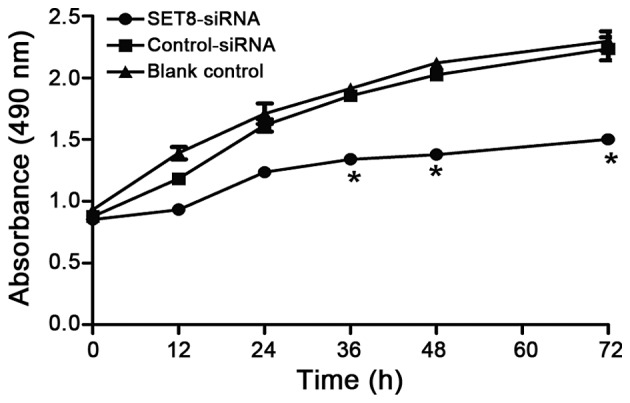
SET8-knockdown cells were subjected to MTT assay to determine cell proliferation. *P<0.05 vs. control-siRNA and blank group (n=3). siRNA, small interfering RNA; SET8, SET domain containing (lysine methyltransferase) 8.
Figure 4.
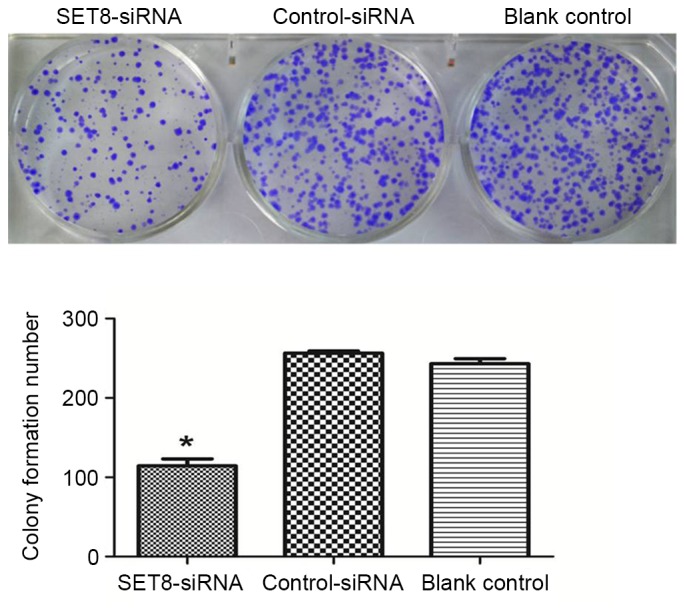
SET8-knockdown inhibits renal carcinoma 786-O cell colony formation by colony formation assay. *P<0.05 vs. control-siRNA and blank group (n=3). siRNA, small interfering RNA; SET8, SET domain containing (lysine methyltransferase) 8.
Figure 5.
SET8-knockdown attenuates c-Myc and MMP-7 mRNA expression in renal carcinoma 786-O cells (n=3). MMP-7, matrix metalloproteinase-7; siRNA, small interfering RNA; SET8, SET domain containing (lysine methyltransferase) 8.
To determine whether SET8 affects cell migration or invasion, wound healing and Transwell assays were performed, respectively. As presented in Fig. 6, SET8-knockdown significantly decreased cell migration capacity compared with cells transfected with empty vector or blank control cells (P<0.05). Cell invasion was examined using Transwell assays and it was revealed that SET8-knockdown markedly decreased cell invasiveness compared with cells transfected with empty vector or blank control cells (P<0.05; Fig. 7). To determine the mechanisms by which SET8 regulates invasion and migration, RT-PCR was performed. Compared with cells transfected with control-siRNA, SET8-knockdown cells exhibited significantly decreased matrix metalloproteinase-7 (MMP-7) levels (Fig. 5). These results indicated that SET8-knockdown inhibited cell migration and invasion. It was suggested that SET8-knockdown suppresses cell migration and invasion by decreasing MMP-7 mRNA expression.
Figure 6.
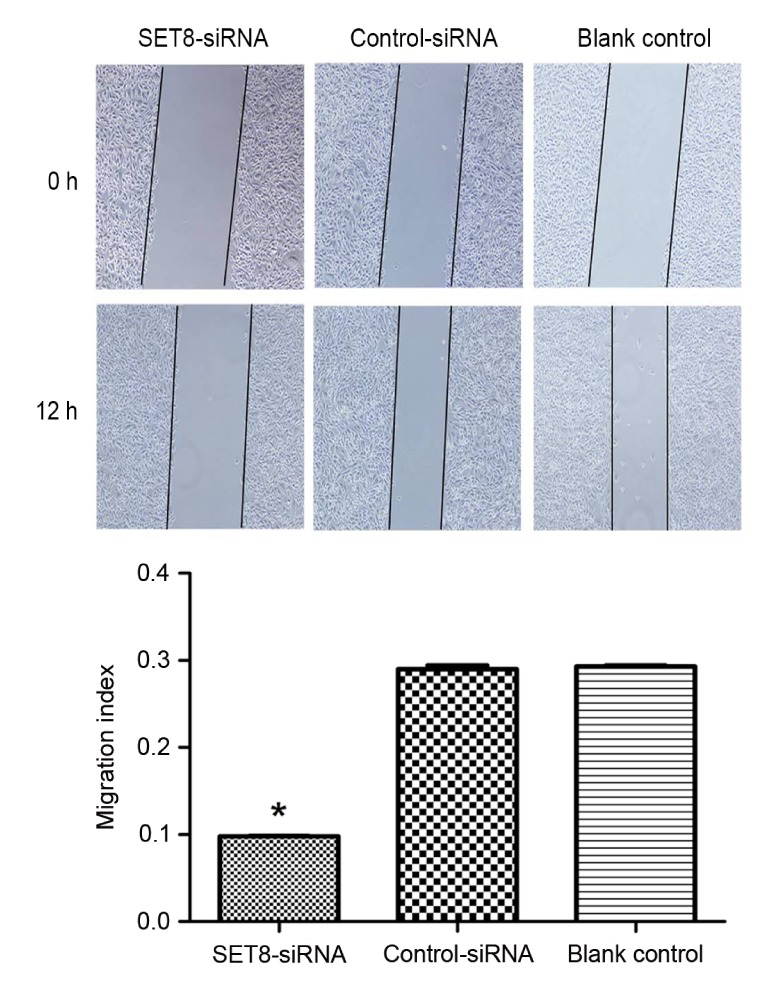
SET8-knockdown suppresses renal carcinoma 786-O cell migration by wound healing assay. *P<0.05 vs. control-siRNA and blank group (n=3). siRNA, small interfering RNA; SET8, SET domain containing (lysine methyltransferase) 8.
Figure 7.
SET8-knockdown suppresses renal carcinoma 786-O cell invasion by Transwell assay. *P<0.05 vs. control-siRNA and blank group (n=3). siRNA, small interfering RNA; SET8, SET domain containing (lysine methyltransferase) 8.
Discussion
In the present study, the association between the rs16917496 SNP in the miR-502 binding site of the SET8 3′UTR and SET8 expression was assessed, and its implications in ccRCC development were investigated. Logistic regression analysis revealed that the rs16917496 SNP was associated with ccRCC risk. Therefore, the association between the rs16917496 SNP and SET8 expression was examined. Consistent with the previous study by Song et al (21), the present study revealed that the SET8 CC genotype was associated with low SET8 protein expression. Furthermore, the association between SET8 expression and clinicopathological features was explored, and it was revealed that SET8 expression was associated with TNM staging, tumor size and lymph node metastasis. Finally, SET8-knockdown inhibited proliferation and invasion of renal carcinoma 786-O cells, potentially through Wnt/β-catenin signaling. The present data suggested that altering SET8 expression, at least partially by the rs16917496 SNP in the miR-502 binding site of the SET8 3′UTR, was associated with ccRCC development and progression. SET8-knockdown inhibited renal carcinoma 786-O cell proliferation, migration and invasion potentially through Wnt/β-catenin signaling.
Accumulating evidence has suggested that polymorphisms within miRNA-binding sites may affect miRNA regulation of target gene expression and consequently modify cancer risk and outcome (11,32–35). The rs16917496 SNP in the miR-502 binding site of SET8 has been associated with the risk of several tumor types, including hepatocellular carcinoma (10), small cell lung cancer (20) and non-Hodgkin's lymphoma (30). Consistent with the study by Song et al (18), the results of the present study revealed that the CC genotype was associated with low protein expression and low ccRCC risk. The present results also revealed that SET8 expression was associated with TNM staging, tumor size and lymph node metastasis of patients with ccRCC. These data demonstrated that the rs16917496 SNP in the miR-502 binding site of SET8 mediated SET8 expression and consequently modified ccRCC cancer risk.
As a methyltransferase, SET8 may regulate several signaling pathways by modulating protein lysine methyltransferases. Of note, the major signaling pathways affected by SET8 are Wnt/β-catenin (36) and twist (37), which are important for development. The Wnt/β-catenin pathway is highly conserved across metazoans and is essential for a number of cellular functions, including cell proliferation, migration and invasion (38). The present study demonstrated that SET8-knockdown inhibited proliferation and invasion by mediating the expression of the Wnt/β-catenin target genes c-Myc and MMP-7 in renal carcinoma 786-O cells. However, expression of other Wnt target genes, including Axin2, naked cuticle homolog 1 and lymphoid enhancer-binding factor 1, was not detected. The full mechanism of SET8 regulation of renal carcinoma cell proliferation and invasion and its associated signaling pathways should be explored further.
The present results indicated that SNPs of a miRNA binding site were associated with ccRCC risk, but the results require validation in other populations and in laboratory-based functional studies. SET8 may modify cancer development and progression through its effects on proliferation and invasion, potentially via Wnt/β-catenin signaling. Therefore, SET8 may be a novel target for ccRCC therapy.
Acknowledgements
The present study was supported by the project of the Hebei Natural Science Fund (grant no. H2012206157) and the project of the Hebei Major Medical Science (grant no. GL2011-51), and the Project of Hebei Science and Technology Planning (16397733D).
References
- 1.Remon J, Lianes P, Martinez S. Brain metastases from renal cell carcinoma. Should we change the current standard? Cancer Treat Rev. 2012;38:249–257. doi: 10.1016/j.ctrv.2011.06.008. [DOI] [PubMed] [Google Scholar]
- 2.Salehipoor M, Khezri A, Behzad-Behbahani A, Geramizadeh B, Rahsaz M, Aghdaei M, Afrasiabi MA. Role of viruses in renal cell carcinoma. Saudi J Kidney Dis Transpl. 2012;23:53–57. [PubMed] [Google Scholar]
- 3.Ferlay J, Soerjomataram I, Dikshit R, Eser S, Mathers C, Rebelo M, Parkin DM, Forman D, Bray F. Cancer incidence and mortality worldwide: Sources, methods and major patterns in GLOBOCAN 2012. Int J Cancer. 2015;136:E359–E386. doi: 10.1002/ijc.29210. [DOI] [PubMed] [Google Scholar]
- 4.Chow WH, Dong LM, Devesa SS. Epidemiology and risk factors for kidney cancer. Nat Rev Urol. 2010;7:245–257. doi: 10.1038/nrurol.2010.46. [DOI] [PMC free article] [PubMed] [Google Scholar]
- 5.Semenza JC, Ziogas A, Largent J, Peel D, Anton-Culver H. Gene-environment interactions in renal cell carcinoma. Am J Epidemiol. 2001;153:851–859. doi: 10.1093/aje/153.9.851. [DOI] [PubMed] [Google Scholar]
- 6.Gu L, Li H, Chen L, Ma X, Gao Y, Li X, Zhang Y, Fan Y, Zhang X. MicroRNAs as prognostic molecular signatures in renal cell carcinoma: A systematic review and meta-analysis. Oncotarget. 2015;6:32545–32560. doi: 10.18632/oncotarget.5324. [DOI] [PMC free article] [PubMed] [Google Scholar]
- 7.Sellitti DF, Doi SQ. MicroRNAs in renal cell carcinoma. Microrna. 2015;4:26–35. doi: 10.2174/2211536604666150713105247. [DOI] [PubMed] [Google Scholar]
- 8.Klimczak D, Pączek L, Jażdżewski K, Kuch M. MicroRNAs: Powerful regulators and potential diagnostic tools in cardiovascular disease. Kardiol Pol. 2015;73:1–6. doi: 10.5603/KP.a2014.0210. [DOI] [PubMed] [Google Scholar]
- 9.Chiang VS. Withdrawn: MicroRNAs as potential regulators of docosahexaenoic acid benefits in Alzheimer's disease. Nutr Neurosci. 2015 Mar 14; doi: 10.1179/1476830515Y.0000000014. (Epub Ahead Of Print) [DOI] [PubMed] [Google Scholar]
- 10.Mennigen JA, Plagnes-Juan E, Figueredo-Silva CA, Seiliez I, Panserat S, Skiba-Cassy S. Acute endocrine and nutritional co-regulation of the hepatic omy-miRNA-122b and the lipogenic gene fas in rainbow trout, Oncorhynchus mykiss. Comp Biochem Physiol B Biochem Mol Biol. 2014;169:16–24. doi: 10.1016/j.cbpb.2013.12.002. [DOI] [PubMed] [Google Scholar]
- 11.Guo Z, Wu C, Wang X, Wang C, Zhang R, Shan B. A polymorphism at the miR-502 binding site in the 3′-untranslated region of the histone methyltransferase SET8 is associated with hepatocellular carcinoma outcome. Int J Cancer. 2012;131:1318–1322. doi: 10.1002/ijc.27352. [DOI] [PubMed] [Google Scholar]
- 12.Liu Y, Cai H, Liu J, Fan H, Wang Z, Wang Q, Shao M, Sun X, Diao J, Liu Y, et al. A miR-151 binding site polymorphism in the 3′-untranslated region of the cyclin El gene associated with nasopharyngeal carcinoma. Biochem Biophys Res Commun. 2013;432:660–665. doi: 10.1016/j.bbrc.2013.02.024. [DOI] [PubMed] [Google Scholar]
- 13.Couture JF, Collazo E, Brunzelle JS, Trievel RC. Structural and functional analysis of SET8, a histone H4 Lys-20 methyltransferase. Genes Dev. 2005;19:1455–1465. doi: 10.1101/gad.1318405. [DOI] [PMC free article] [PubMed] [Google Scholar]
- 14.Fang J, Feng Q, Ketel CS, Wang H, Cao R, Xia L, Erdjument-Bromage H, Tempst P, Simon JA, Zhang Y. Purification and functional characterization of SET8, a nucleosomal histone H4-lysine 20-specific methyltransferase. Curr Biol. 2002;12:1086–1099. doi: 10.1016/S0960-9822(02)00924-7. [DOI] [PubMed] [Google Scholar]
- 15.Nishioka K, Rice JC, Sarma K, Erdjument-Bromage H, Werner J, Wang Y, Chuikov S, Valenzuela P, Tempst P, Steward R, et al. PR-Set7 is a nucleosome-specific methyltransferase that modifies lysine 20 of histone H4 and is associated with silent chromatin. Mol Cell. 2002;9:1201–1213. doi: 10.1016/S1097-2765(02)00548-8. [DOI] [PubMed] [Google Scholar]
- 16.Wu S, Wang W, Kong X, Congdon LM, Yokomori K, Kirschner MW, Rice JC. Dynamic regulation of the PR-Set7 histone methyltransferase is required for normal cell cycle progression. Genes Dev. 2010;24:2531–2542. doi: 10.1101/gad.1984210. [DOI] [PMC free article] [PubMed] [Google Scholar]
- 17.Huen MS, Sy SM, van Deursen JM, Chen J. Direct interaction between SET8 and proliferating cell nuclear antigen couples H4-K20 methylation with DNA replication. J Biol Chem. 2008;283:11073–11077. doi: 10.1074/jbc.C700242200. [DOI] [PMC free article] [PubMed] [Google Scholar]
- 18.Jørgensen S, Elvers I, Trelle MB, Menzel T, Eskildsen M, Jensen ON, Helleday T, Helin K, Sørensen CS. The histone methyltransferase SET8 is required for S-phase progression. J Cell Biol. 2007;179:1337–1345. doi: 10.1083/jcb.200706150. [DOI] [PMC free article] [PubMed] [Google Scholar]
- 19.Tardat M, Murr R, Herceg Z, Sardet C, Julien E. PR-Set7-dependent lysine methylation ensures genome replication and stability through S phase. J Cell Biol. 2007;179:1413–1426. doi: 10.1083/jcb.200706179. [DOI] [PMC free article] [PubMed] [Google Scholar]
- 20.Abbas T, Shibata E, Park J, Jha S, Karnani N, Dutta A. CRL4 (Cdt2) regulates cell proliferation and histone gene expression by targeting PR-Set7/Set8 for degradation. Mol Cell. 2010;40:9–21. doi: 10.1016/j.molcel.2010.09.014. [DOI] [PMC free article] [PubMed] [Google Scholar]
- 21.Song F, Zheng H, Liu B, Wei S, Dai H, Zhang L, Calin GA, Hao X, Wei Q, Zhang W, Chen K. An miR-502-binding site single-nucleotide polymorphism in the 3′-untranslated region of the SET8 gene is associated with early age of breast cancer onset. Clin Cancer Res. 2009;15:6292–6300. doi: 10.1158/1078-0432.CCR-09-0826. [DOI] [PubMed] [Google Scholar]
- 22.Ding C, Li R, Peng J, Li S, Guo Z. A polymorphism at the miR-502 binding site in the 3′ untranslated region of the SET8 gene is associated with the outcome of small-cell lung cancer. Exp Ther Med. 2012;3:689–692. doi: 10.3892/etm.2012.469. [DOI] [PMC free article] [PubMed] [Google Scholar]
- 23.Wang C, Guo Z, Wu C, Li Y, Kang S. A polymorphism at the miR-502 binding site in the 3′ untranslated region of the SET8 gene is associated with the risk of epithelial ovarian cancer. Cancer Genet. 2012;205:373–376. doi: 10.1016/j.cancergen.2012.04.010. [DOI] [PubMed] [Google Scholar]
- 24.Singh M, Zaino RJ, Filiaci VJ, Leslie KK. Relationship of estrogen and progesterone receptors to clinical outcome in metastatic endometrial carcinoma: A gynecologic oncology group study. Gynecol Oncol. 2007;106:325–333. doi: 10.1016/j.ygyno.2007.03.042. [DOI] [PubMed] [Google Scholar]
- 25.Merritt WM, Lin YG, Han LY, Kamat AA, Spannuth WA, Schmandt R, Urbauer D, Pennacchio LA, Cheng JF, Nick AM, et al. Dicer, Drosha, and outcomes in patients with ovarian cancer. N Engl J Med. 2008;359:2641–2650. doi: 10.1056/NEJMoa0803785. [DOI] [PMC free article] [PubMed] [Google Scholar]
- 26.Chen L, Qiu J, Yang C, Yang X, Chen X, Jiang J, Luo X. Identification of a novel estrogen receptor beta1 binding partner, inhibitor of differentiation-1, and role of ERbeta1 in human breast cancer cells. Cancer Lett. 2009;278:210–219. doi: 10.1016/j.canlet.2009.01.008. [DOI] [PubMed] [Google Scholar]
- 27.Tan B, Li Y, Zhao Q, Fan L, Wang D, Liu Y. Inhibition of gastric cancer cell growth and invasion through siRNA-mediated knockdown of guanine nucleotide exchange factor Vav3. Tumour Biol. 2014;35:1481–1488. doi: 10.1007/s13277-013-1204-2. [DOI] [PubMed] [Google Scholar]
- 28.Meng F, Wang F, Wang L, Wong SC, Cho WC, Chan LW. MiR-30a-5p overexpression may overcome EGFR-inhibitor resistance through regulating PI3K/AKT signaling pathway in non-small cell lung cancer cell lines. Front Genet. 2016;7:197. doi: 10.3389/fgene.2016.00197. [DOI] [PMC free article] [PubMed] [Google Scholar]
- 29.Süer E, Baltaci S, Burgu B, Aydoğdu Ö, Göğüş Ç. Significance of tumor size in renal cell cancer with perinephric fat infiltration: Is TNM staging system adequate for predicting prognosis? Urol J. 2013;10:774–779. [PubMed] [Google Scholar]
- 30.Diao L, Su H, Wei G, Li T, Gao Y, Zhao G, Guo Z. Prognostic value of microRNA 502 binding site SNP in the 3′-untranslated region of the SET8 gene in patients with non-Hodgkin's lymphoma. Tumori. 2014;100:553–558. doi: 10.1700/1660.18180. [DOI] [PubMed] [Google Scholar]
- 31.Wang C, Wu J, Zhao Y, Guo Z. miR-502 medaited histone methyltransferase SET8 expression is associated with outcome of esophageal squamous cell carcinoma. Sci Rep. 2016;6:32921. doi: 10.1038/srep32921. [DOI] [PMC free article] [PubMed] [Google Scholar]
- 32.Landi D, Gemignani F, Naccarati A, Pardini B, Vodicka P, Vodickova L, Novotny J, Försti A, Hemminki K, Canzian F, Landi S. Polymorphisms within micro-RNA-binding sites and risk of sporadic colorectal cancer. Carcinogenesis. 2008;29:579–584. doi: 10.1093/carcin/bgm304. [DOI] [PubMed] [Google Scholar]
- 33.Gao Y, He Y, Ding J, Wu K, Hu B, Liu Y, Wu Y, Guo B, Shen Y, Landi D, et al. An insertion/deletion polymorphism at miRNA-122-binding site in the interleukin-1alpha 3′ untranslated region confers risk for hepatocellular carcinoma. Carcinogenesis. 2009;30:2064–2069. doi: 10.1093/carcin/bgp283. [DOI] [PubMed] [Google Scholar]
- 34.Horikawa Y, Wood CG, Yang H, Zhao H, Ye Y, Gu J, Lin J, Habuchi T, Wu X. Single nucleotide polymorphisms of microRNA machinery genes modify the risk of renal cell carcinoma. Clin Cancer Res. 2008;14:7956–7962. doi: 10.1158/1078-0432.CCR-08-1199. [DOI] [PMC free article] [PubMed] [Google Scholar]
- 35.Hu Z, Chen J, Tian T, Zhou X, Gu H, Xu L, Zeng Y, Miao R, Jin G, Ma H, et al. Genetic variants of miRNA sequences and non-small cell lung cancer survival. J Clin Invest. 2008;118:2600–2608. doi: 10.1172/JCI34934. [DOI] [PMC free article] [PubMed] [Google Scholar]
- 36.Konac E, Varol N, Yilmaz A, Menevse S, Sozen S. DNA methyltransferase inhibitor-mediated apoptosis in the Wnt/β-catenin signal pathway in a renal cell carcinoma cell line. Exp Biol Med (Maywood) 2013;238:1009–1016. doi: 10.1177/1535370213498984. [DOI] [PubMed] [Google Scholar]
- 37.Yang F, Sun L, Li Q, Han X, Lei L, Zhang H, Shang Y. SET8 promotes epithelial-mesenchymal transition and confers TWIST dual transcriptional activities. EMBO J. 2012;31:110–123. doi: 10.1038/emboj.2011.364. [DOI] [PMC free article] [PubMed] [Google Scholar]
- 38.Clevers H, Nusse R. Wnt/β-catenin signaling and disease. Cell. 2012;149:1192–1205. doi: 10.1016/j.cell.2012.05.012. [DOI] [PubMed] [Google Scholar]



